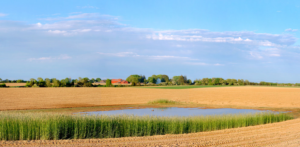Measuring Water Quality Outcomes – Six Success Stories

In 2010, USDA’s Natural Resources Conservation Service (NRCS) used a project- and partnership-based conservation approach to help clean up agricultural watersheds through the Mississippi River Basin Healthy Watershed Initiative (MRBI). I wanted to know how well these voluntary watershed projects were doing, and if they had documented cleaner water using the monitoring systems encouraged by NRCS.
NRCS recognized that the way to clean up streams—whether impaired by soil erosion, fertilizer, pesticides, or pathogen runoff from farm fields—is to concentrate conservation financial and technical assistance on upstream areas with the highest potential to reduce pollution—and to have a credible in-stream monitoring program in place to track the changes.
State water quality agencies and their watershed partners have been doing this work for years through the U.S. Environmental Protection Agency (EPA)’s Section 319 Nonpoint Source Management Program. Since 2005, they have published 405 program success stories about restoring 674 waterbodies on the EPA website. These voluntary watershed conservation projects are a very important and exciting way to support farmers as they adopt conservation practices that make sense for their businesses and for cleaner water. NRCS encourages partners to pursue geographic targeting and measuring outcomes through MRBI, the National Water Quality Initiative (NWQI), and the new Regional Conservation Partnership Program (RCPP), among other efforts.
During my evaluation of MRBI projects, I found that identifying success stories was very difficult. That may be because not enough time has passed to demonstrate in-stream improvements from land use changes, or because the projects had trouble implementing or setting up the monitoring. Or it’s possible that in-stream improvements were documented but not shared with NRCS.
Despite the challenges, I did find six success stories, initiated under a variety of program frameworks, from five states: California, Oklahoma, Iowa, two in one watershed in Wisconsin, and Indiana. Farmers, landowners, and project leaders worked together in various watersheds to achieve cleaner water, from nut orchards in California to rolling landscapes with livestock in Iowa and flat row-crop farm fields in Indiana. Funds for the conservation practices, the monitoring, or project management stemmed from many sources, including but not limited to: NRCS’s Bay Delta Initiative, EPA’s Section 319 Program, Iowa’s Water Improvement Review Board, Wisconsin’s Department of Natural Resource, NRCS’s Cooperative Conservation Partnerships Initiative, and NRCS’s Conservation Innovation Grants (CIG).
Some of the most interesting factors that project leaders attributed to their success included:
- Fostering farmer leadership (in CA, OK, and IA) so that farmers were in the driver’s seat deciding how to respond to the pollution problem in their watershed.
- Using geographic targeting tools (OK, IA, WI) to identify the fields with the highest potential for phosphorus losses and then collaborating with farmers to help them adopt the right conservation practices to reduce the excess phosphorus in the stream.
- Using paired, upstream/downstream, and before/after monitoring programs (OK, WI, IN) to detect improvements in key water quality parameters and credibly attribute those improvements to the farm conservation practices.
These success stories highlight how farmers and landowners are part of the solution to achieving healthier streams and lakes. And it demonstrates to the public how their taxpayer investments in conservation programs are paying off. To that end, I make numerous recommendations in my new report to advance watershed-based conservation and quantification of outcomes, including:
- Congress should provide more financial and technical assistance to farmers and conservationists through the Farm Bill and the EPA-state Section 319 programs for watershed conservation projects;
- USDA should offer greater technical guidance to the new RCPP project leaders who want to quantify environmental, social, and economic outcomes associated with their project’s conservation practices; and
- Corporations and charitable foundations should support more watershed-focused and outcomes-quantification work.
A webinar to discuss the report and these recommendations, including keynote remarks from Dave White, former Chief of NRCS, is scheduled for Wednesday, May 24 at 12:30 pm eastern to 2 pm. For more information and to register, please click here.

